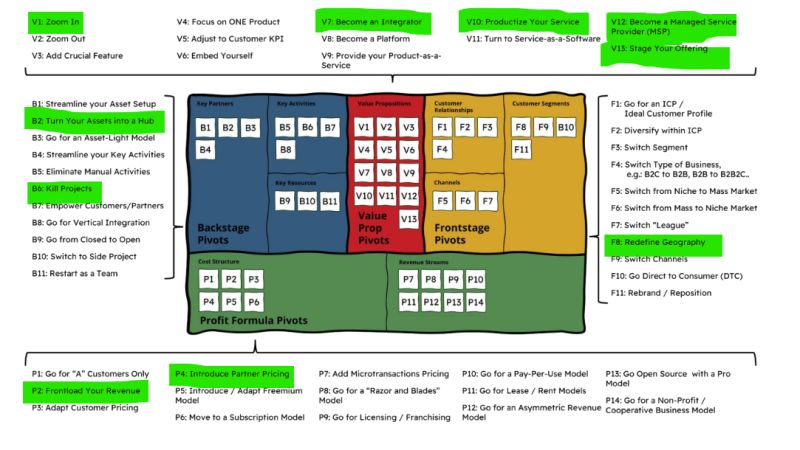I just wrapped up a workshop with a tech startup that hit a flat growth phase.
Let’s call that company ACME 1.
The management team of ACME 1 came to me with a bunch of ideas, questions & vague hypotheses on what to do next.
Clearly, they were stuck.
To top it off, one of their investors was pushing them in a direction that didn’t feel right to them.
Before we got into any pivot discussions, I checked the first thing that matters:
𝟭. “𝗗𝗼𝗲𝘀 𝘁𝗵𝗲 𝗰𝗼𝗺𝗽𝗮𝗻𝘆 𝗵𝗮𝘃𝗲 𝗲𝗻𝗼𝘂𝗴𝗵 𝗿𝘂𝗻𝘄𝗮𝘆?”
In my experience, you need 12 months of cash to experiment properly.
If that’s a no (and even if yes), see if you can reduce the burn rate and extend your runway.
Luckily, ACME 1 had 18+ months of runway, check ✅
𝟮. 𝗖𝗼𝗹𝗹𝗲𝗰𝘁 𝗱𝗮𝘁𝗮
Next, I proposed to establish a solid basis for discussion.
This is where the Pivotal Framework comes in: It helps cut through the guesswork.
Essentially the first part of this framework consists of 60 questions covering all major areas of the Business Model Canvas: Value Proposition, Front Stage, Back Stage and the Profit Formula Area.
ACME 1 invited nine decision makers to answer those questions:
4 internal specialists from ACME 1
and 5 external experts.
Each person had to rate each question on a scale of -3 to +3.
𝟯. 𝗧𝘂𝗿𝗻𝗶𝗻𝗴 𝗱𝗮𝘁𝗮 𝗶𝗻𝘁𝗼 𝗮𝗰𝘁𝗶𝗼𝗻: 𝘁𝗵𝗲 𝘄𝗼𝗿𝗸𝘀𝗵𝗼𝗽
Once we had gathered that data, my role was to moderate the discussion.
We went for a half day workshop.
Looking at the answers, we got straight to the strengths, weaknesses, opportunities & threats of ACME 1.
As always, some perceptions lined up. Others were all over the place.
A spread isn’t a problem — it’s a signal. It showed us exactly where the biggest gaps and critical aligment areas were.
To make sense of it all, we used the “Pivotal Engine” — another tool of the framework:
The Engine suggest typical pivot paths a company could take based on patterns in their data.
For ACME 1, the engine flagged 10 (out of 49) promising paths worth a deeper look.
You’d think this is AI magic. But it’s really just a simple matching mechanism.
Next, the team did something smart. They split these 10 ideas into three buckets:
Exploit (do it now): Three immediate changes they can make. Tweak, expand, or cut activities immediately.
Experiment (test it out): Four ideas worth experimenting. They decided to use about 10% of their resources for these pivot patterns.
Explore (research more): Three paths needing more insights. They decided to arrange a series of calls with subject matter experts.
All of it happened in just five hours.
I’ll check back with the team in 3 months. (Will keep you posted).

